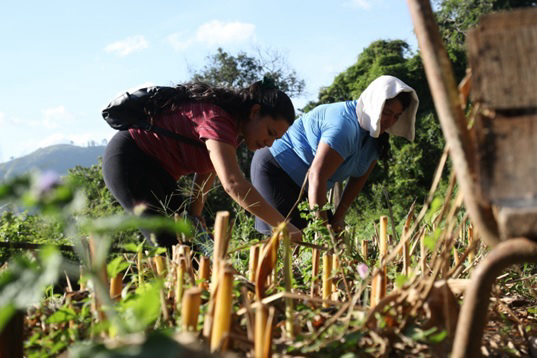Disclaimer:
Please be aware that the content herein has not been peer reviewed. It consists of personal reflections, insights, and learnings of the contributor(s). It may not be exhaustive, nor does it aim to be authoritative knowledge.
Overview
Prepared by (Name of the experimenter)
Víctor Tablas
On date (Day/Month/Year)
06/12/2023
What action learning plan is this activity related to?
Climate Information Products for farmers
Design
What is the specific learning intent of the activity? Why is it important to do this experiment?
The experimental activity design focused on understanding how farmers respond to climate adaptation messages. We conducted surveys with randomly assigned items, delivered through CAPI (Computer-Assisted Personal Interviewing) to local farmers. By dividing participants into treatment and control groups, we tested if peer actions influence farmers’ willingness to adopt adaptive practices. Additionally, framing experiments examined how different contexts impact attitudes toward adaptation, and traditional knowledge tests assessed whether integrating indigenous practices with forecasts can build trust in official weather data.
What is your hypothesis? IF... THEN....
If farmers observe that their peers are adopting climate adaptation practices, then they will be more likely to adopt similar practices themselves.
If climate adaptation information is framed positively (e.g., emphasizing potential benefits), then farmers’ attitudes toward adopting adaptation measures will improve.
If traditional knowledge (such as wildlife behavior and lunar phases) is combined with official climate forecasts, then farmers’ trust in the accuracy and reliability of weather information will increase.
If climate information is delivered through accessible and familiar channels (e.g., WhatsApp groups), then farmers will be more likely to regularly use this information in their decision-making.
Does the activity use a control group for comparison?
Yes, a different group entirely
Describe which actions, with whom, where, when will you (or did you) take to test your hypothesis:
We designed and administered surveys where certain items (questions or statements) were randomized, meaning that different farmers received different versions of the survey. This random assignment helps us understand how varying pieces of information or framing can influence responses, as it controls for potential biases. The surveys were delivered directly to farmers in person using CAPI (Computer-Assisted Personal Interviewing), a data collection method where enumerators use electronic devices, like tablets, to input responses in real time. This method improves data accuracy and speeds up the data collection process.
If you worked with partners, please choose what sector they belong to (select all that apply)
Civil Society
What is the total estimated monetary resources needed for this experiment?
Between 10,000- and 20,000 USD
Please upload any supporting images or visuals for this experiment.
Please upload any supporting links
Results
Was the original hypothesis (If.. then) proven or disproven? In which way do the results support the original hypothesis or not?
The hypotheses were generally supported by the experiment's results. We hypothesized that if climate adaptation practices were framed as already adopted by local peers, farmers would show a higher motivation to implement these practices themselves. The results confirmed this: 87.5% of the treatment group—those informed about peer adoption—expressed motivation to adopt similar measures, compared to 76.7% in the control group.
Additionally, framing adaptation benefits versus risks differently influenced farmer perception. When information was framed negatively (risks of not adapting), it had a stronger impact, with 75% of farmers seeing climate change impacts as likely compared to 41% when presented positively. These findings highlight the influence of peer examples and loss aversion in climate adaptation motivation.
What are the most important learning outcomes of the experiment? Are any changes recommended?
Peer Influence Enhances Motivation: Farmers were more motivated to adopt climate adaptation practices when they perceived them as popular among their peers. This shows that a social proof approach can drive higher adoption rates in climate adaptation.
Framing Matters: Presenting information with a negative framing (emphasizing risks of inaction) proved more effective in making farmers feel the urgency of adapting to climate change than positive framing (emphasizing benefits of action). This highlights that loss aversion is a strong motivator in this context.
Trust in Traditional Knowledge: Farmers showed high confidence in traditional climate knowledge, and the combination of traditional insights with meteorological data seemed to foster even more trust. This indicates that integrating familiar, culturally resonant information with scientific data is likely more effective.
Preference for Mobile Access: Despite low internet access, farmers showed a preference for receiving information on mobile devices. This suggests that efforts to improve digital infrastructure could greatly enhance information reach.
Considering the outcomes of this experimental activity, which of the following best describe what happened after? (Please select all that apply)
This experiment did not scale yet
Please add any supporting links that describe the planning, implementation, results of learning of this activity? For example a tweet, a blog, or a report.
Learning
What were the main obstacles and challenges you encountered during this activity? What advise would you give colleagues trying to replicate this experimental activity?
Limited Internet Access: Data collection was hampered by limited internet availability in rural areas, making it difficult to upload survey data in real time and requiring offline workarounds.
Geographic and Logistical Constraints: Reaching remote agricultural communities required extensive planning, both in terms of transport logistics and ensuring that data collection tools (e.g., tablets) were fully functional offline.
Technological Familiarity and Comfort: Many farmers were unfamiliar with digital devices, and some preferred traditional communication methods, which required careful adaptation of survey tools and materials.
Language and Cultural Nuances: Conveying climate information required adapting language and framing that resonated with the local culture and knowledge systems.


 1No poverty
1No poverty 5Gender equality
5Gender equality 12Responsible consumption and production
12Responsible consumption and production 13Climate action
13Climate action
Comments
Log in to add a comment or reply.